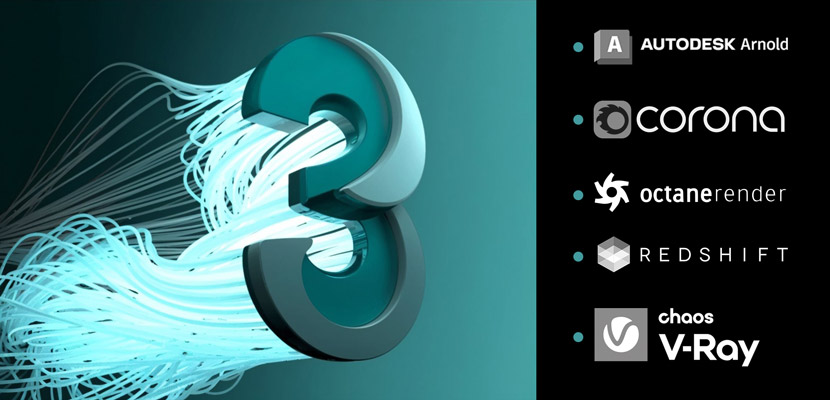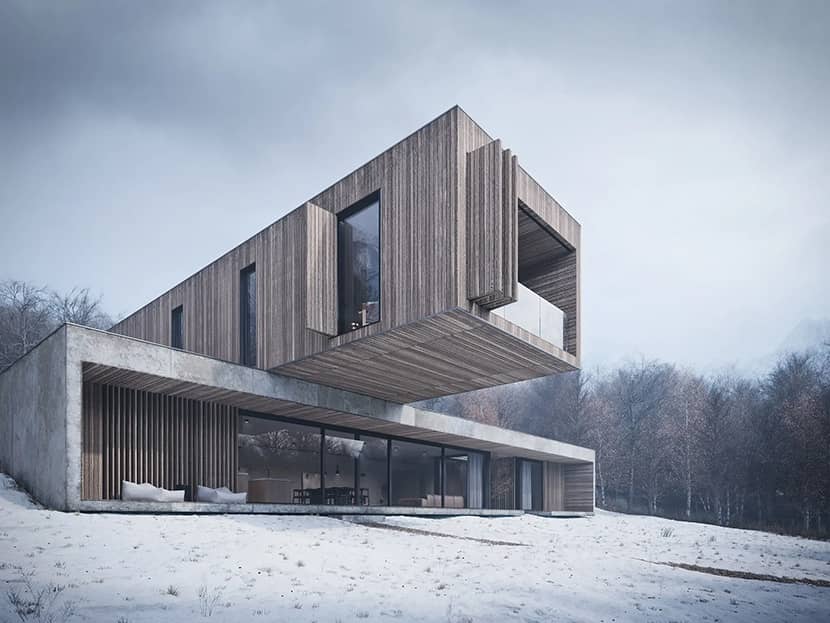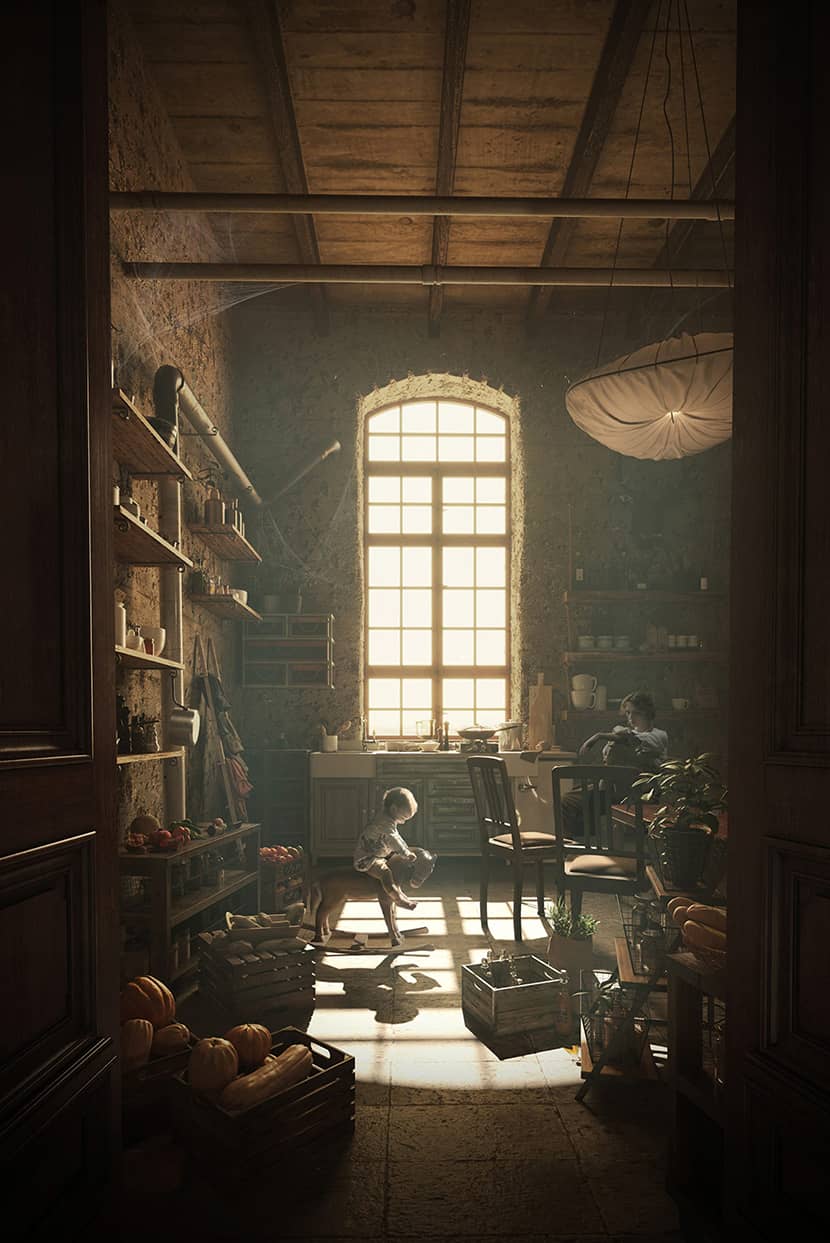
In this article, we showcase some of the best 3ds Max render engines out there. Learn about their history and most important features, and enjoy showreels that describe their abilities. We also answer which one is the best. You know... a renderer is only as good as the artist behind it!
Introduction to 3ds Max Render Engines
Autodesk's 3ds Max has been the most popular 3D software for many years. Millions of artists use it as their primary tool for computer graphics, from architectural visualizations to game projects and film productions. Even if 3ds Max is more than twenty-five years old, it is still very famous, and many large studios or even smaller teams and individuals have created their whole workflow around it, including the usage of render farms, making the inversion venture almost impossible.
Many tools and render engines support 3ds Max. Additionally, there are substantial 3D libraries that artists can use in their projects, and this is something that you can't change easily.
This article will review some of the best 3ds Max renderers to improve the photorealistic results artists seek with fast and accurate results. To be honest, the differences between them are really tiny.
What is a 3D Render Engine?
A rendering engine is, let's say, an "add-on/plug-in" to the 3D software that helps to calculate the lighting and physical properties of the materials used in a more photorealistic way than the standard renderer that comes with a particular 3D software.
There are two types of renderers:
- Ray-tracing renderers: Some of them are Arnold, Corona Renderer, Fstorm, Redshift, Octane, and V-Ray, which use actual calculations of the light rays hitting the surfaces and adjust the appearance of the image based on the physical properties of the materials.
- Real-time renderers: Some of them are Unreal Engine, Eevee in Blender, or Unity. These are most commonly found in the gaming industry and rely primarily on fast approximations of shadows, preset (baked-in) lighting, and other memory-saving techniques.
Searching online to find opinions and conclusions about the several render engines in our market, we discovered Andrey Lebrov, Head of CG & VFX at Lebrov Motion Imagery Ltd. In the following video, he compares V-Ray and Octane renderers as an example of making a very targeted statement: "No matter if a render engine is biased or unbiased. Everything we are doing, VFX, CG, or motion graphics, it's not true; it's not real. So it's biased anyway, to some extent. Any image, photo, or video is generated by light, but CG and VFX scenes are generated with the rendering process by digital rays that bounce, reflect, and absorb in our digital scene."
Understanding the Role of Rendering in 3D Animation and Design
The 3D rendering process is an essential technique for several industries, including advertising, product and automotive design, architecture, video games, and VFX for films and television.
In the design and architectural industries, rendered images enable creatives to communicate their designs/ideas clearly and transparently. They allow them to evaluate their experiments with materials and lighting studies and compare their designs in the real world before they are materialized.
In the media and entertainment industries, rendered images are used to create animated stories, whether we're watching animated movies or VFX sequences with visual effects, such as scary creatures, explosions, fumes, and other similar digital creations.
Let's check some of the best render engines for 3ds Max. We will do that in alphabetical order.
Arnold Render Engine
Solid Angle developed Arnold Renderer in the late 1990s. Marcos Fajardo, Arnold's chief architect, decided to write his renderer when he attended SIGGRAPH, where his interest in stochastic ray tracing was piqued in discussions with friends attending the conference. Early versions were called RenderAPI. The name Arnold emerged when one of Fajardo's friends suggested it after mocking an Arnold Schwarzenegger film they saw in a theater.
In 2004, he entered a co-development agreement with Sony Pictures, which resulted in separate branches for Arnold's commercial and proprietary versions. The commercial version was integrated via plugins into several software such as Softimage, Maya, Katana, Cinema4D, and Houdini. In early 2016, Autodesk purchased it, and it is now bundled with Maya and 3ds Max.
Many films and TV Series have used Arnold, such as Alice in Wonderland, Thor, Captain America, X-Men, Elysium, Gravity, Guardians of the Galaxy, Star Wars, Arrival, Blade Runner 2049, Game of Thrones, and others.

Arnold Renderer used by Cinesite Studios.
Key Features of Arnold Renderer for 3ds Max
Arnold is a path-traced Monte-Carlo renderer that generates high-quality, realistic scenes with minimal tweaking. The realism of Arnold's rendering algorithms is one of the reasons many studios adopted it as their primary render engine. It is also well-known for being the top VFX and film production renderer.
The key features of Arnold are:
| Arnold GPU | OSL support | Standard Surface shader |
| Motion blur | Toon shader | Standard Hair shader |
| Subdivision and displacement | Hair and fur | Alembic procedural |
| Adaptive sampling | Light Path Expressions | Profiling API and statistics |
| Subsurface scatter | Denoising | Material assignments |
| Volumes | Flexible and extensible API | Built-in Cryptomatte |
| USD support | Stand-alone command-line | Integrated OpenColorIO v2 |
Check out some of 2023's most epic blockbusters, episodics, games, and commercials – created using Autodesk software like Maya, 3ds Max, Arnold, Flame, and ShotGrid.
Corona Render Engine
Corona Renderer was created in 2009 by Ondrej Karlik. By that time, GPU renderers were on the rise, but he considered that CPU rendering had great potential. He started the development as a solo student project at the Czech Technical University in Prague. He was later joined by former CGI artist Adam Hotovy and Jaroslav Krivanek, associate professor and researcher at Charles University in Prague, and they founded the company Render Legion.
The team planned to create Corona Renderer for Blender. Still, it was impossible to launch a commercial product due to the restrictive GNU GPL license, so the development focused on Autodesk 3ds Max, and Corona was officially released in 2015 after 6 years of alpha development.
In 2017, Chaos Group acquired Render Legion, and the 2022 version of Corona Renderer was rebranded to Chaos Corona. It's worth mentioning that Corona is also available for Cinema 4D.

Corona Render by Guilherme Pinheiro from AX2 Studio.
Key Features of Corona Renderer for 3ds Max
Corona is a CPU rendering engine that provides both biased and unbiased rendering options. Using the path-tracing engine gives an unbiased result, and using precomputations with a secondary engine increases processing time while making outcomes slightly biased.
Corona also allows using GPU-based AI denoising instead of CPU denoising, and it comes with three rendering options:
- Progressive, which refines the whole frame to the desired quality.
- Bucket, which makes numerous passes, refining the buckets where needed, notably reducing rendering time in scenes with large uniform areas.
- BiDir/VCM mode for scenes that need clear caustics.
The key features of Corona Renderer are:
| Biased and Unbiased solution | Path Tracing | UHD and 4K (experimental) cache |
| Denoising | Fast Caustics Solver | Adaptive Image Sampling |
| CoronaSky | CoronaSun | Corona Light Material |
| CoronaLight | Interactive lightmix | Interactive rendering |
| Environment | Corona Virtual Frame Buffer | Corona Image Editor |
| Chaos Cosmos | Chaos Scatter | Corona Decal |
| Corona Slicer Material | CoronaPhysicalMtl | CoronaLegacyMtl |
| CoronaSkinMtl | CoronaSkinMtl | CoronaHairMtl |
| CoronaLayeredMtl | CoronaSelectMtl | CoronaLightMtl |
| CoronaRaySwitchMtl | CoronaShadowCatcherMtl | CoronaShadowCatcherMtl |
| CoronaVolumeMtl | 3ds Max materials | 3ds Max physical material |
| Material library | Texmaps | Corona Pattern |
| CoronaProxy | CoronaVolumeGrid | Post-processing effects |
| Corona Camera | Camera effects | Corona Camera Mod |
| Exposure and color mapping | Render elements | Distributed rendering |
| Chaos Corona Toolbar | Corona Unified Lister | VR |
A quick 3-minute showreel of some of the best animation work created in 2020 using Corona Renderer.
Octane Render Engine
OTOY is the 3D design company that is redefining content creation and delivery for media and entertainment organizations worldwide. Their innovative OctaneRender® is used by leading visual effects studios, artists, animators, designers, architects, and engineers. It provides unprecedented creative freedom and new levels of realism.
The company was founded in 2008 by Jules Urbach (Founder & CEO) and Malcolm Taylor (Co-Founder & CTO). Since then, the company has grown to over 60 employees across four offices, with headquarters in downtown Los Angeles, CA. It also has some critical investors and advisers.
Jules sets the strategic direction and vision for the company and is the chief architect of OTOY's technology roadmap. He created the web's first 3D video game platform and licensed the software to Macromedia, Disney, Warner Brothers, Nickelodeon, Microsoft, Hasbro, and AT&T. Hailed by technology writer George Gilder as "the most inventive software engineer he has ever met".

Octane Render by Martin Schropp.
Key Features of Octane Renderer for 3ds Max
According to the official Otoy website, OctaneRender® is the world’s first and fastest unbiased, spectrally correct GPU render engine, delivering quality and speed unrivaled by any production renderer on the market.
OctaneRender® Studio+ Subscriptions allow artists and studios full access to OTOY's acclaimed OctaneRender VFX software and ecosystem with Unlimited network rendering (10+ nodes) and offline rendering support. The unbiased technology offers astonishing quality with slight or no tweaking in post-production.
The key features of Octane are:
| Physically-based / Spectral Light Transport | Unbiased and Direct Lighting / Ambient Occlusion | Custom Sampling Algorithm (Custom MLT-like implementation) |
| Multiple GPU Support | Geometry Instances | Render Passes |
| Object Visibility (On / Off for Shadow Casting) | Displacement Mapping | Object Motion Blur |
| Hair / Fur Primitives | OpenSubDiv Surfaces | Region Rendering |
| Network Rendering | HDRI + Sun Environment | Packaging to .ORBX File |
| Animation Support via Alembic Format | Pause / Resume Render | Built-in Firefly Removal Tool |
| Info-Channel Kernel Mode | Stereo Modes | Post-Processing Settings |
| Out-of-Core Textures Support | Integration Kernal Tile and Sampling Control Options | Volume Rendering |
| Texture Animation Support | Texture Baking System | Deep Image Rendering |
| Export to Octane Render Cloud Option | Photoshop Compositing Extension | Denoiser |
| Octane AI System | Integrated Brigade Game Engine | UDIM and Complex PBR Textures |
The world's top artists created a collection of beautiful film and television content using OTOY's award-winning OctaneRender GPU software.
Redshift Render Engine
Redshift was initially developed by California-based Redshift Rendering Technologies Inc. and debuted in 2014 as a biased production renderer designed to utilize NVIDIA GPUs. It provides granular control over what is reflected and refracted in your scene at render time and uses techniques to concentrate samples in areas that need them most selectively. In 2019, it was acquired by Maxon.

Redshift Render by Can Erduman.
Key Features of Redshift Renderer for 3ds Max
According to the official Maxon website, Redshift is a powerful GPU-accelerated renderer built to meet the demands of contemporary high-end production rendering. Tailored to support creative individuals and studios of every size, it offers robust features to its users and integrates with industry-standard CG applications.
The software's biased approach doesn't waste samples on less critical regions. This optimization often allows it to deliver clean renders much faster than unbiased methods.
The key features of Redshift are:
| Out-of-core geometry and textures | Global Illumination | World-leading performance |
| Proxies | Transformation and deformation blur | Volumetric Rendering |
| Hair rendering with ‘Min Pixel Width’ | Tessellation and displacement | Per-object flexibility |
| Baking | Command-line rendering | SDK |
| Denoising | Redshift CPU | DisorterNode |
| MatCap Shader Node | Jitter Node | Physically Based Materials |
| Ray switches | Hair Shader | Dedicated skin shaders |
| Round corners | Displacement mapping with auto-bump | No texturing limitations |
| Powerful shading attributes | Sprite node | Large variety of nodes |
| Standard surface | Tile Surface | Tile and Brick Shaders |
| PRG Clear Sky | Flakes Shader | Dome Lights |
| Mesh Lights | Volumetric Lighting | Physical sun and sky |
| Physically correct lights | Multiple camera lens types | VR |
| Physical lens effects | Deep and Layered EXR support | Many AOV Types |
A mesmerizing visual experience that showcases the best of digital art and animation made with the Maxon Redshift renderer.
V-Ray Render Engine
Chaos is a rendering and simulation software developer headquartered in Karlsruhe, Germany and Sofia, Bulgaria. It was founded in 1997 by Peter Mitev and Vladimir Koylazov, and it's well known for developing V-Ray since 2002.
In 2017, the company acquired Czech software developer Render Legion, known for Corona Renderer, later rebranding the subsidiary to Chaos Czech.
In 2021, the company rebranded from Chaos Group to Chaos.
In 2022, the company merged with German software developer Enscape, with the resulting company maintaining the Chaos brand. Following the merger, Chaos acquired the Danish 3D product visualization platform developer Cylindo.
In 2023, Chaos acquired the Italian software developer AXYZ design, known for their crowd animation software anima and their range of stock 3D characters metropoly.

V-Ray Render by Deepak Jain.
Key Features of V-Ray for 3ds Max
V-Ray is a biased computer-generated imagery rendering software application developed by the Bulgarian software company Chaos. V-Ray is a commercial plug-in for third-party 3D computer graphics software applications and is used for visualizations and computer graphics in industries such as media, entertainment, film, and video game production, industrial design, product design, and architecture.
V-Ray is a rendering engine that uses global illumination algorithms, including path tracing, photon mapping, irradiance maps, and directly computed global illumination.
The key features of V-Ray are:
| CPU and GPU Rendering | Denoising | Chaos Cloud Rendering |
| Chaos Cloud Collaboration | Ready-to-render assets | Initial Enscape compatibility |
| USD and MaterialX support | Unified V-Ray Lister | Progressive caustics |
| Resumable Rendering | Debug Shading | Native ACEScg support |
| Procedural clouds | Multiple additive Dome Lights | Finite dome light mode |
| Adaptive Lights | V-Ray Light Custom Decay | Atmospheric light contribution control |
| Lighting Analysis tools | Accurate Lights | Global Illumination |
| Sun and Sky model | Lens Effects | Point & Shoot Camera |
| Photorealistic Cameras | Custom resolution per camera | Virtual Reality |
| Advanced material override | Improved V-Ray Material in viewport | Physical Hair Material |
| Metalness | Physically Based Materials | V-Ray Toon Shader |
| Chaos Scans Material Library support | Material presets | Coat layer |
| Sheen layer | Thin Film layer | Memory-efficient Textures |
| Triplanar Mapping | Rounded Corners | Texture randomization |
| Stochastic texture tiling | V-Ray Dirt | Chaos Scatter |
| V-Ray Enmesh | V-Ray Decal | Proxy Geometry |
| Clipper with Render-Time Booleans | Hair & Fur | Specialty Geometry |
| Volume Rendering | Aerial Perspective | Light Mix |
| Layer compositor | Pixel-perfect masks in the V-Ray Frame Buffer | Sharpen/Blur layer in V-Ray Frame Buffer |
Dive into a mesmerizing tapestry of cutting-edge VFX and animation featured in the latest blockbuster movies, TV series, game cinematics, ads, and more brought to life through the power of V-Ray & Chaos Phoenix.
Conclusion: Which Render Engine Is The Best For 3ds Max?
Well, that's an excellent question with no obvious answer!
The best rendering engine always depends on the user, who can only discover one after experimenting with many. All of them are available for a free trial, so you can try them out before deciding. When choosing a 3ds Max renderer, there are many things to investigate, such as:
Speed: Of course, we believe that speed is a top consideration, but it also depends on the types of projects we usually handle. Benchmarks can help us explore how fast or slow a render engine is, but they're not 100% accurate, as many factors can affect rendering speed.
Quality: Well, as far as we've seen here and there on several forums, all render engines can provide us with stunning results, but combining these results with speed and a user-friendly interface could be a crucial point for choosing the one we feel most comfortable with.
Flexibility: Another possible issue for users who are used to maximizing their large-scale scenes through extensive use of advanced features such as proxies, procedural tools, and various effects. The renderer that can help us handle this type of scenes, is probably the one we need.
Libraries: An equally important topic for productivity. Which render engine is the most used for material and 3D model libraries? The more pre-made stuff we can find on the internet, the more productive we can be.
We could continue analyzing and unfolding arguments, but ultimately, what engine we choose to render our projects depends on our needs as artists. The best is the one that provides us with speed and quality to make ourselves and the client happy and to make our lives easier. These days, a renderer is as good as the artist behind it.
Last but not least, we consider cost another essential factor, but as we used to say, "no pain, no gain."
We hope that we helped you understand how to select a render engine according to your needs, and we wish you happy rendering!

About the author
Vasilis Koutlis, the founder of VWArtclub, was born in Athens in 1979. After studying furniture design and decoration, he started dedicating himself to 3D art in 2002. In 2012, the idea of VWArtclub was born: an active 3D community that has grown over the last 12 years into one of the largest online 3D communities worldwide, with over 160 thousand members. He acquired partners worldwide, and various collaborators trusted him with their ideas as he rewarded them with his consistent state-of-the-art services. Not a moment goes by without him thinking of a beautiful image; thus, he is never concerned with time but only with the design's quality.
